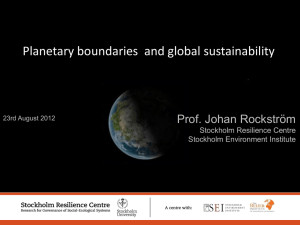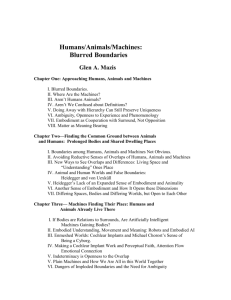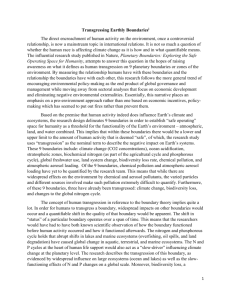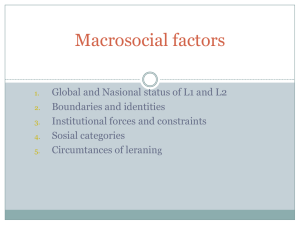Media Release
advertisement
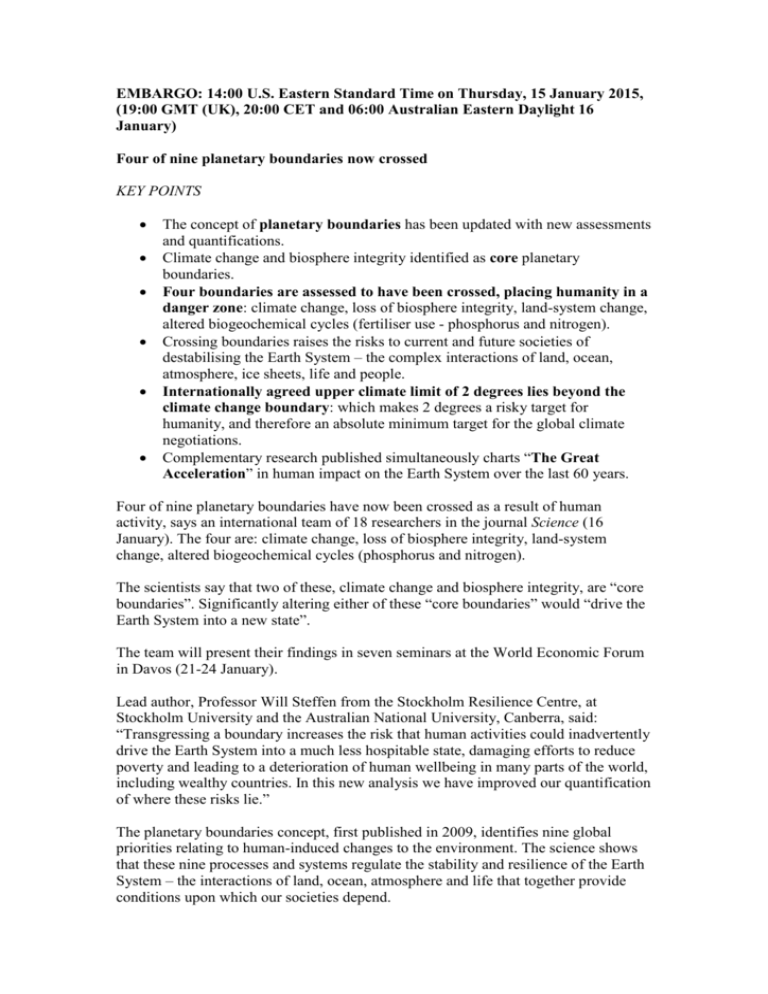
EMBARGO: 14:00 U.S. Eastern Standard Time on Thursday, 15 January 2015, (19:00 GMT (UK), 20:00 CET and 06:00 Australian Eastern Daylight 16 January) Four of nine planetary boundaries now crossed KEY POINTS The concept of planetary boundaries has been updated with new assessments and quantifications. Climate change and biosphere integrity identified as core planetary boundaries. Four boundaries are assessed to have been crossed, placing humanity in a danger zone: climate change, loss of biosphere integrity, land-system change, altered biogeochemical cycles (fertiliser use - phosphorus and nitrogen). Crossing boundaries raises the risks to current and future societies of destabilising the Earth System – the complex interactions of land, ocean, atmosphere, ice sheets, life and people. Internationally agreed upper climate limit of 2 degrees lies beyond the climate change boundary: which makes 2 degrees a risky target for humanity, and therefore an absolute minimum target for the global climate negotiations. Complementary research published simultaneously charts “The Great Acceleration” in human impact on the Earth System over the last 60 years. Four of nine planetary boundaries have now been crossed as a result of human activity, says an international team of 18 researchers in the journal Science (16 January). The four are: climate change, loss of biosphere integrity, land-system change, altered biogeochemical cycles (phosphorus and nitrogen). The scientists say that two of these, climate change and biosphere integrity, are “core boundaries”. Significantly altering either of these “core boundaries” would “drive the Earth System into a new state”. The team will present their findings in seven seminars at the World Economic Forum in Davos (21-24 January). Lead author, Professor Will Steffen from the Stockholm Resilience Centre, at Stockholm University and the Australian National University, Canberra, said: “Transgressing a boundary increases the risk that human activities could inadvertently drive the Earth System into a much less hospitable state, damaging efforts to reduce poverty and leading to a deterioration of human wellbeing in many parts of the world, including wealthy countries. In this new analysis we have improved our quantification of where these risks lie.” The planetary boundaries concept, first published in 2009, identifies nine global priorities relating to human-induced changes to the environment. The science shows that these nine processes and systems regulate the stability and resilience of the Earth System – the interactions of land, ocean, atmosphere and life that together provide conditions upon which our societies depend. Nine planetary boundaries 1. Climate change 2. Change in biosphere integrity (biodiversity loss and species extinction) 3. Stratospheric ozone depletion 4. Ocean acidification 5. Biogeochemical flows (phosphorus and nitrogen cycles) 6. Land-system change (for example deforestation) 7. Freshwater use 8. Atmospheric aerosol loading (microscopic particles in the atmosphere that affect climate and living organisms) 9. Introduction of novel entities (e.g. organic pollutants, radioactive materials, nanomaterials, and micro-plastics). Managing these priorities at safe global levels will enable world development within a safe operating space on Earth, say the researchers. The new research builds on a large number of scientific publications critically assessing and improving the planetary boundaries research since its original publication. It confirms the original set of boundaries and provides updated analysis and quantification for several of them, including phosphorus and nitrogen cycles, land-system change, freshwater use and biosphere integrity. Biosphere integrity relates to the scale and impact of humans on ecosystems. As human activity pushes the Earth System beyond planetary boundaries and into zones of increasing risk, marine ecosystems may change dramatically as a result of ocean acidification and eutrophication, or temperatures may rise so high as to pose significant threats to agricultural production, infrastructure and human health. The paper reports that continuing degradation of biosphere integrity will likely further erode the provision of ecosystem services on which human societies depend. “Past a certain threshold, curbing greenhouse gas emissions, biodiversity loss, or land-use change, for example, may not reverse or even slow the trends of Earth System degradation, with potentially catastrophic consequences,” said Professor Steffen. “Planetary Boundaries do not dictate how human societies should develop but they can aid decision-makers by defining a safe operating space for humanity,” says coauthor Katherine Richardson from the Center for Macroecology, Evolution and Climate, University of Copenhagen. This week, co-author Professor Johan Rockström, director of the Stockholm Resilience Centre, will present the new findings at the World Economic Forum. “In the last four years we have worked closely with policymakers, industry and organisations like WWF to explore how the planetary boundaries approach can be used as a framework for sectors of societies to reduce risk while developing sustainably.” “It is obvious that different societies over time have contributed very differently to the current state of the earth. The world has a tremendous opportunity this year to address global risks, and do it more equitably. In September, nations will agree the UN’s Sustainable Development Goals. With the right ambition, this could create the conditions for long-term human prosperity within planetary boundaries,” he said. Eight of the nine planetary boundaries have been quantified (see table at end). With climate change, for example, the team argue that carbon dioxide levels should not cross 350 parts per million (ppm) in the atmosphere. “This boundary is consistent with a stabilisation of global temperatures at about 1.5 degrees Celsius above preindustrial levels,” said Professor Rockström. Atmospheric concentrations of carbon dioxide are currently about 399ppm (December 2014) and growing at about 3ppm per year. In December 2015, nations will meet in Paris to negotiate an international emissions agreement to attempt to stabilise temperatures at 2 degrees Celsius above preindustrial levels. “Our analysis suggests that, even if successful, reaching this target contains significant risks for societies everywhere. Two degrees must therefore be seen not only as a necessary but also a minimum global climate target,” said Professor Rockström. The planetary boundaries research coincides with a second analysis, also led by Professor Will Steffen, that charts “The Great Acceleration” in human activity since 1950. The paper, “The trajectory of the Anthropocene: the Great Acceleration”, focuses on a planetary “dashboard” of 24 social, economic and environmental indicators. The assessment concludes that the global economic system is the prime driver of change of key components of the Earth System, supporting the need for a precautionary approach to transgressing planetary boundaries. Notes to editors Planetary Boundaries (Red indicates a boundary has been transgressed) Planetary Boundary Control Variable(s) Boundary The value in brackets indicates the estimated zone of uncertainty Current Value Climate change Atmospheric CO2 concentration, ppm 350 ppm CO2 (350-450 ppm) 396.5 ppm CO2 Energy imbalance: +1.0 W m-2 (+1.0-1.5 W m-2) 2.3 W m-2 (1.1-3.3 W m2 ) Energy imbalance at top-ofatmosphere, (Watts per metre squared, Wm-2) Change in biosphere integrity Genetic diversity: Extinction rate Functional: diversity: Biodiversity Intactness Index (BII) Stratospheri Stratospheric O3 c ozone concentration, depletion Dobson Units Ocean acidificatio n Biogeoche mical flows: (Phosphoru s and Nitrogen cycles) Carbonate ion concentration, average global surface ocean saturation state with respect to aragonite (Ωarag ) Phosphorus cycle: Global: Phosphorus flow from freshwater systems into the ocean Genetic: less than 10 extinctions per million species-years (E/MSY), (10-100 E/MSY) Functional: Maintain the Biodiversity Intactness Index at 90% (90-30%) or above, assessed geographically by biomes/large regional areas (e.g. southern Africa), major marine ecosystems (e.g., coral reefs) or by large functional groups <5% reduction from preindustrial level of 290 Dobson Units (5%–10%), assessed by latitude ≥80% of the pre-industrial aragonite saturation state of mean surface ocean, including natural diel and seasonal variability ( ≥80%– ≥70%) Phosphorus cycle: Global: 11 Tg P yr-1 (11100 Tg P yr-1) 100-1000 E/MSY 84%, applied to southern Africa only Only transgressed over Antarctica in Austral spring (~200 DU) ~84% of the pre-industrial aragonite saturation state ~22 Tg P yr-1 Regional: Phosphorus flow Regional: 6.2 Tg yr-1 ~14 Tg P yr-1 from fertilizers mined and applied to to erodible soils erodible (agricultural) soils (6.2-11.2 Tg yr-1). Boundary is a global average but regional distribution is critical for Nitrogen cycle: impacts. Global: Industrial and 62 Tg N yr-1 (62-82 Tg N ~150 Tg N yr-1 -1 intentional yr ). Boundary acts as a biological global ‘valve’ limiting fixation of nitrogen. Landsystem change Freshwater use Atmospheri c aerosol loading introduction of new reactive nitrogen to the Earth System, but regional distribution of fertilizer nitrogen is critical for impacts. Global: area of Global: 75% (75-54%) 62% forested land Values are a weighted as % of original average of the three forest cover individual biome boundaries and their uncertainty zones Biome: area of Biome: forested land Tropical: 85% (85-60%) as % of potential Temperate: 50% (50-30%) forest Boreal: 85% (85-60%) Global: Global: 4000 km3 yr-1 ~2600 km3 yr-1 3 -1 Maximum (4000-6000 km yr ) amount of consumptive blue water use (km3yr-1) Basin: Maximum monthly withdrawal as a percentage Basin: Blue of mean monthly river water flow. For low-flow withdrawal as % months: 25% (25-55%); of mean for intermediate-flow monthly river months: 30% (30-60%); flow for high-flow months: 55% (55-85%) Global: Aerosol Optical Depth (AOD), but much regional variation Regional: AOD as a seasonal average over a region. South Asian Monsoon used as a case study Introductio n of novel entities No control variable currently defined Regional: (South Asian 0.30 AOD, Monsoon as a case study): over South anthropogenic total Asian region (absorbing and scattering) AOD over Indian subcontinent of 0.25 (0.250.50); absorbing (warming) AOD less than 10% of total AOD No boundary currently identified, but see boundary for stratospheric ozone for an example of a boundary related to a novel entity (CFCs) Further information Research papers Planetary Boundaries: Guiding human development on a changing planet (Science) 16 January 2015. Available on request. The trajectory of the Anthropocene: The Great Acceleration (Anthropocene Review) 16 January 2015. Available on request. Background papers Discussions about the planetary boundaries started in 2008 at a workshop convened by Stockholm Resilience Centre, Stockholm Environment Institute and the Tällberg Foundation. A safe operating space for humanity (Nature) 24 September 2009. http://www.nature.com/nature/journal/v461/n7263/full/461472a.html Planetary boundaries: exploring the safe operating space for humanity’, Ecology and Society, 14 (2), 32. http://www.ecologyandsociety.org/vol14/iss2/art32/ Imagery available on request Planetary boundaries figure 24 Great Acceleration graphs Links for more information Planetary boundaries research www.stockholmresilience.org/21/research/research-programmes/planetaryboundaries.html Planetary boundaries www.sei-international.org/planetary-boundaries Identifying chemicals that are Planetary boundary threats www.sei-international.org/publications?pid=2579 Contact Fredrik Moberg Communications Stockholm Resilience Centre fredrik.moberg@stockholmresilience.su.se Tel: +46 (0)70 680 65 53 Owen Gaffney Communications International Geosphere-Biosphere Programme (Stockholm) owen.gaffney@igbp.kva.se Tel: +46(0) 730208418 Ylva Rylander Communications Stockholm Environment Institute ylva.rylander@sei-international.org Phone: +46 (0) 731503384 Contributing institutions Stockholm Resilience Centre, Stockholm University, Sweden Fenner School of Environment and Society, The Australian National University, Canberra, Australia Center for Macroecology, Evolution and Climate, Natural History Museum, University of Copenhagen, Denmark McGill University, Ste. Anne de Bellevue, Québec, Canada Centre for Studies in Complexity, Stellenbosch University, South Africa University of Wisconsin, Madison WI USA Wageningen University Alterra, Wageningen, The Netherlands Stockholm University, Sweden Beijer Institute of Ecological Economics, Stockholm, Sweden Potsdam Institute of Climate Impact Research (PIK), Potsdam, Germany University College, London, UK Stockholm Environment Institute, Stockholm, Sweden Scripps Institution of Oceanography, La Jolla CA USA Council for Scientific and Industrial Research (CSIR), Stellenbosch, South Africa Royal Institute of Technology (KTH), Stockholm, Sweden

